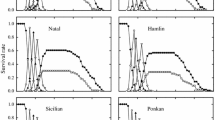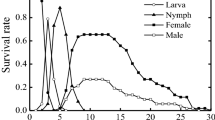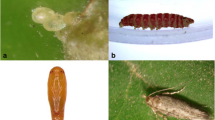Abstract
Brevipalpus yothersi Baker (Acari: Tenuipalpidae) was recently confirmed as one of the main vectors of citrus leprosis. Knowledge about this mite’s biology is essential to understand its population dynamics, in order to solve management issues in citrus orchards and explain why citrus leprosis is more severe in some regions. This paper aimed to study biological factors affecting prevailing population levels of B. yothersi and incidence of citrus leprosis. Mites were sampled from orchards in the south, north and northwestern regions of São Paulo State, Brazil. We assessed duration of the developmental stages, oviposition, incubation period, egg viability, longevity, net reproductive rate (Ro), mean generation time (T), intrinsic rate of increase (rm) and finite rate of increase (λ). There were small differences in parameter values between the three populations. Our results indicated that the various measures adopted in the control of the three populations did not lead to major biological differences between populations for the evaluated parameters.

Similar content being viewed by others
References
Akkopru EP, Atlihan R, Okut H, Chi H (2015) Demographic assessment of plant cultivar resistance to insect pests: a case study of the dusky-veined walnut aphid (Hemiptera: Callaphididae) on five walnut cultivars. J Econ Entomol 108:378–387
Alves EB (1999) Manejo da resistência do ácaro-da-leprose Brevipalpus phoenicis (Geijskes, 1939) (Acari: Tenuipalpidae) ao acaricida Dicofol. Dissertação, Universidade de São Paulo
Andrade DJ, Falconi RS, Siqueira DS, Barbosa CL, Ferraudo AS, Oliveira CAL (2013) The influence of citrus rootstocks on the relationship between the mite Brevipalpus phoenicis and citrus leprosis disease. Pest Manag Sci 69:81–87
Bassanezi RB, Spósito MB, Yamamoto PT (2002) Adeus à leprose. Cultivar 2:6–8
Bassanezi RB, Ayres AJ, Massari CA, Belasque Junior J, Barbosa JC (2014) Progressão e distribuição espacial das principais pragas dos citros. In: Andrade DJ, Ferreira MC, Martinelli NM (eds) Aspectos da fitossanidade em citros. Cultura Acadêmica, Jaboticabal, pp 31–50
Bastianel M, Novelli VM, Kitajima EW, Kubo KS, Bassanezi RB, Machado MA, Freitas-Astúa J (2010) Citrus leprosis: centennial of an unusual mite virus pathosystem. Plant Dis 94:284–292
Beard JJ, Ochoa R, Braswell WE, Bauchan GR (2015) Brevipalpus phoenicis(Geijskes) species complex (Acari: Tenuipalpidae)—a closer look. Zootaxa 3944:1–67
Chi H (1988) Life table analysis incorporating both sexes and variable development rates among individuals. Environ Entomol 17:26–34
Chi H (2016) TWOSEX-MSChart: a computer program for the age-stage, two-sex life table analysis. http://140.120.197.173/ecology/Download/TWOSEX-MSChart.rar. Accessed 25 May 2016
Chi H, Liu H (1985) Two new methods for the study of insect population ecology. Bull Inst Zool 24:225–240
Chi H, Su HY (2006) Age-stage, two-sex life tables of Aphidius gifuensis(Ashmead) (Hymenoptera: Braconidae) and its host Myzus persicae (Sulzer) (Homoptera: Aphididae) with mathematical proof of the relationship between female fecundity and the net reproductive rate. Environ Entomol 35:10–21
Chiavegato LG (1986) Biologia do ácaro Brevipalpus phoenicis em citros. Pesq Agro Bra 21:13–16
Efron B, Tibshirani RJ (1993) An introduction to the bootstrap. Chapman and Hall, New York
Fellous S, Angot G, Orsucci M, Migeon A, Auger P, Olivieri I, Navajas M (2014) Combining experimental evolution and field population assays to study the evolution of host range breadth. J Evol Biol 27:911–919
Guedes RNC, Cutler GC (2014) Insecticide- induced hormesis and arthropod pest management. Pest Manag Sci 70:690–697
Haramoto FH (1966) Biology and control of Brevipalpus phoenicis (Geijskes) (Acarina: Tenuipalpidae). Hawaii Agricultural Experiment Statation, Honolulu
Huang YB, Chi H (2012) Age-stage, two-sex life tables of Bactrocera cucurbitae (Coquillett) (Diptera: Tephritidae) with a discussion on the problem of applying female age-specific life tables to insect populations. Insect Sci 19:263–273
INMET - Instituto Nacional de Meteorologia (2015) Disponível em: <www.inmet.gov.br/> Acesso em: 08 novembro 2015
Laranjeira FF, Silva SXB, Andrade EC, Almeida DO, Silva TSM, Soares ACF, Freitas-Astuá J (2015) Infestation dynamics of Brevipalpus phoenicis (Geijskes) (Acari: Tenuipalpidae) in citrus orchards as affected by edaphic and climatic variables. Exp Appl Acarol 66:491–508
Medeiros MB (2002) Ação de biofertilizantes líquidos sobre a bioecologia do ácaro Brevipalpus phoenicis. Tese, Universidade de São Paulo
Mineiro JLC, Sato ME, Novelli VM, Andrade DJ (2015) Distribuição de Brevipalpus yothersi Baker, 1949 (Acari: Tenuipalpidae) em diferentes hospedeiras e localidades no estado de São Paulo. 28a Reunião Anual do Instituto Biológico, São Paulo
Oliveira CAL (1986) Flutuação populacional e medidas de controle do ácaro Brevipalpus phoenicis em citros. Laranja 6:1–32
Pascual-Ruiz S, Gomez-Martinez MA, Ansaloni T, Segarra-Moragues JG, Sabater-Munoz B, Jacas JA (2014) Genetic structure of a phytophagous mite species affected by crop practices: the case of Tetranychus urticae in clementine mandarins. Exp Appl Acarol 62:477–498
Roy A, Hartung JS, Schneider WL, Shao J, León MG, Melzer MJ, Beard JJ, Otero-Colina G, Bauchan GR, Ochoa R, Brlansky RH (2015) Role bending: complex relationships between viruses, hosts and vectors related to citrus leprosis, an emerging disease. Phytopathol 105:1013–1025
Salinas-Vargas D, Santillán-Galicia MT, Guzmán-Franco AW, Hernández-López A, Ortega-Arenas LD, Mora-Aguilera G (2016) Analysis of genetic variation in Brevipalpus yothersi (Acari: Tenuipalpidae) populations from four species of citrus host plants. PLoS ONE 11(10):e0164552
Silva SXB, Laranjeira FF, Andrade EC, Almeida DO (2012) Dinâmica da infestação de Brevipalpus phoenicis (Geijskes, 1939) (Acari: Tenuipalpidae) em pomares cítricos da Bahia, Brasil. Rev Bras de Frutic 34:77–83
Souza RS (2002) Aspectos da inter-relação: Ácaro da leprose Brevipalpus phoenicis (Geijskes, 1939) (Acari: Tenuipalpidae), Citrus sinensis (L.) e meio ambiente. Dissertação (Mestrado em Agronomia) – Faculdade de Ciências Agrárias e Veterinárias, Universidade Estadual Paulista
Trindade MLB, Chiavegato LG (1994) Caracterizacao biológica dos ácaros Brevipalpus obovatus D., B. californicus B. e B. phoenicis G. (Acari: Tenuipalpidae). An Soc Entomol Bras 23(2):189–195
Zaher MA, Wafa AK, Yousef AA (1971) Biology of Brevipalpus phoenicis (Geijskes), in Egypt (Acarina:Tenuipalpidae). Bull Soc Entomol d’Egypte 54:177–183
Acknowledgements
The authors thank the Coordination of Higher Education Personnel Improvement—CAPES, for first author’s scholarship; Dr. Alessandra Marieli Vacari, for helping in statistics; Marcio Augusto Soares, for providing mite samples from the Agroterenas farm; and the owners of Vila Rica and Costa e Melo farms, also by providing with mite samples. Our gratitude also extends to Dr. Jeferson Luiz de Carvalho Mineiro for the assistance in identifying the Brevipalpus species.
Author information
Authors and Affiliations
Corresponding author
Rights and permissions
About this article
Cite this article
Amaral, I., de Moraes, G.J., Melville, C.C. et al. Factors affecting prevailing population levels of Brevipalpus yothersi (Acari: Tenuipalpidae) in citrus areas affected by citrus leprosis in the State of Sao Paulo, Brazil. Exp Appl Acarol 74, 395–402 (2018). https://doi.org/10.1007/s10493-018-0239-x
Received:
Accepted:
Published:
Issue Date:
DOI: https://doi.org/10.1007/s10493-018-0239-x




